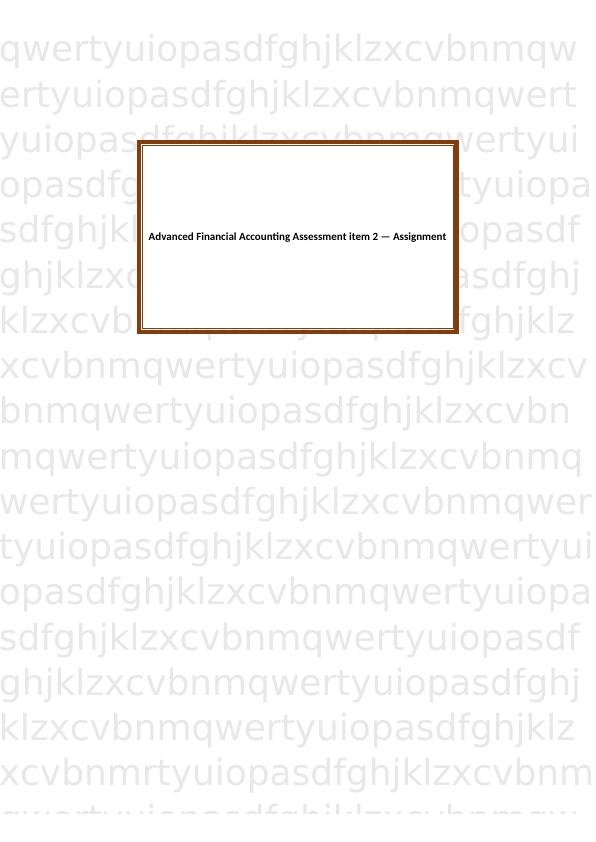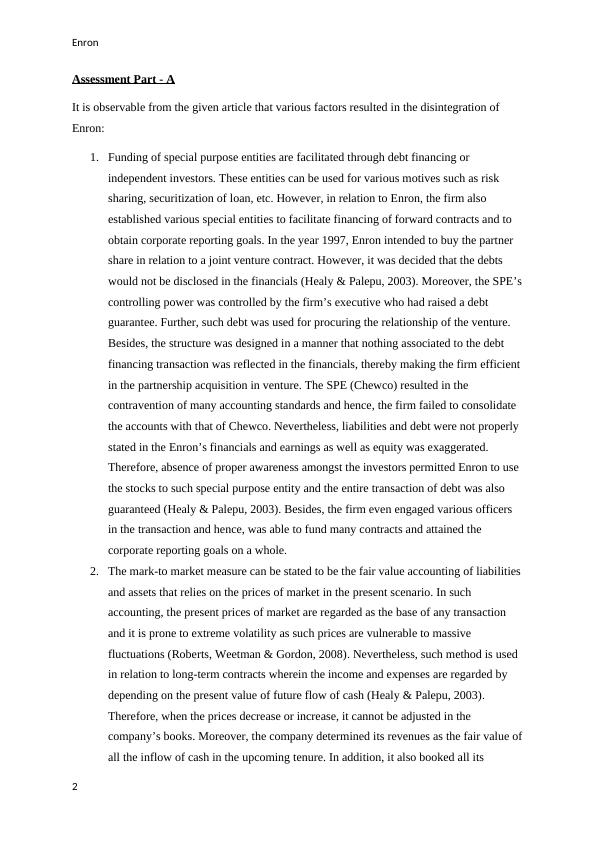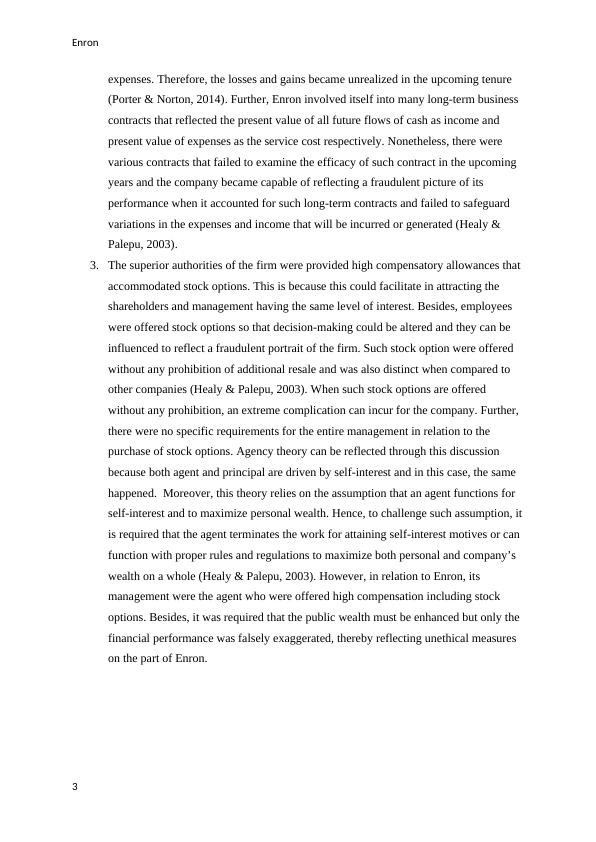Factors that led to the disintegration of Enron and a comparison of IFRS and GAAP standards
Added on 2023-06-04
6 Pages2091 Words461 Views
Advanced Financial Accounting Assessment item 2 — Assignment

Enron
Assessment Part - A
It is observable from the given article that various factors resulted in the disintegration of
Enron:
1. Funding of special purpose entities are facilitated through debt financing or
independent investors. These entities can be used for various motives such as risk
sharing, securitization of loan, etc. However, in relation to Enron, the firm also
established various special entities to facilitate financing of forward contracts and to
obtain corporate reporting goals. In the year 1997, Enron intended to buy the partner
share in relation to a joint venture contract. However, it was decided that the debts
would not be disclosed in the financials (Healy & Palepu, 2003). Moreover, the SPE’s
controlling power was controlled by the firm’s executive who had raised a debt
guarantee. Further, such debt was used for procuring the relationship of the venture.
Besides, the structure was designed in a manner that nothing associated to the debt
financing transaction was reflected in the financials, thereby making the firm efficient
in the partnership acquisition in venture. The SPE (Chewco) resulted in the
contravention of many accounting standards and hence, the firm failed to consolidate
the accounts with that of Chewco. Nevertheless, liabilities and debt were not properly
stated in the Enron’s financials and earnings as well as equity was exaggerated.
Therefore, absence of proper awareness amongst the investors permitted Enron to use
the stocks to such special purpose entity and the entire transaction of debt was also
guaranteed (Healy & Palepu, 2003). Besides, the firm even engaged various officers
in the transaction and hence, was able to fund many contracts and attained the
corporate reporting goals on a whole.
2. The mark-to market measure can be stated to be the fair value accounting of liabilities
and assets that relies on the prices of market in the present scenario. In such
accounting, the present prices of market are regarded as the base of any transaction
and it is prone to extreme volatility as such prices are vulnerable to massive
fluctuations (Roberts, Weetman & Gordon, 2008). Nevertheless, such method is used
in relation to long-term contracts wherein the income and expenses are regarded by
depending on the present value of future flow of cash (Healy & Palepu, 2003).
Therefore, when the prices decrease or increase, it cannot be adjusted in the
company’s books. Moreover, the company determined its revenues as the fair value of
all the inflow of cash in the upcoming tenure. In addition, it also booked all its
2
Assessment Part - A
It is observable from the given article that various factors resulted in the disintegration of
Enron:
1. Funding of special purpose entities are facilitated through debt financing or
independent investors. These entities can be used for various motives such as risk
sharing, securitization of loan, etc. However, in relation to Enron, the firm also
established various special entities to facilitate financing of forward contracts and to
obtain corporate reporting goals. In the year 1997, Enron intended to buy the partner
share in relation to a joint venture contract. However, it was decided that the debts
would not be disclosed in the financials (Healy & Palepu, 2003). Moreover, the SPE’s
controlling power was controlled by the firm’s executive who had raised a debt
guarantee. Further, such debt was used for procuring the relationship of the venture.
Besides, the structure was designed in a manner that nothing associated to the debt
financing transaction was reflected in the financials, thereby making the firm efficient
in the partnership acquisition in venture. The SPE (Chewco) resulted in the
contravention of many accounting standards and hence, the firm failed to consolidate
the accounts with that of Chewco. Nevertheless, liabilities and debt were not properly
stated in the Enron’s financials and earnings as well as equity was exaggerated.
Therefore, absence of proper awareness amongst the investors permitted Enron to use
the stocks to such special purpose entity and the entire transaction of debt was also
guaranteed (Healy & Palepu, 2003). Besides, the firm even engaged various officers
in the transaction and hence, was able to fund many contracts and attained the
corporate reporting goals on a whole.
2. The mark-to market measure can be stated to be the fair value accounting of liabilities
and assets that relies on the prices of market in the present scenario. In such
accounting, the present prices of market are regarded as the base of any transaction
and it is prone to extreme volatility as such prices are vulnerable to massive
fluctuations (Roberts, Weetman & Gordon, 2008). Nevertheless, such method is used
in relation to long-term contracts wherein the income and expenses are regarded by
depending on the present value of future flow of cash (Healy & Palepu, 2003).
Therefore, when the prices decrease or increase, it cannot be adjusted in the
company’s books. Moreover, the company determined its revenues as the fair value of
all the inflow of cash in the upcoming tenure. In addition, it also booked all its
2

Enron
expenses. Therefore, the losses and gains became unrealized in the upcoming tenure
(Porter & Norton, 2014). Further, Enron involved itself into many long-term business
contracts that reflected the present value of all future flows of cash as income and
present value of expenses as the service cost respectively. Nonetheless, there were
various contracts that failed to examine the efficacy of such contract in the upcoming
years and the company became capable of reflecting a fraudulent picture of its
performance when it accounted for such long-term contracts and failed to safeguard
variations in the expenses and income that will be incurred or generated (Healy &
Palepu, 2003).
3. The superior authorities of the firm were provided high compensatory allowances that
accommodated stock options. This is because this could facilitate in attracting the
shareholders and management having the same level of interest. Besides, employees
were offered stock options so that decision-making could be altered and they can be
influenced to reflect a fraudulent portrait of the firm. Such stock option were offered
without any prohibition of additional resale and was also distinct when compared to
other companies (Healy & Palepu, 2003). When such stock options are offered
without any prohibition, an extreme complication can incur for the company. Further,
there were no specific requirements for the entire management in relation to the
purchase of stock options. Agency theory can be reflected through this discussion
because both agent and principal are driven by self-interest and in this case, the same
happened. Moreover, this theory relies on the assumption that an agent functions for
self-interest and to maximize personal wealth. Hence, to challenge such assumption, it
is required that the agent terminates the work for attaining self-interest motives or can
function with proper rules and regulations to maximize both personal and company’s
wealth on a whole (Healy & Palepu, 2003). However, in relation to Enron, its
management were the agent who were offered high compensation including stock
options. Besides, it was required that the public wealth must be enhanced but only the
financial performance was falsely exaggerated, thereby reflecting unethical measures
on the part of Enron.
3
expenses. Therefore, the losses and gains became unrealized in the upcoming tenure
(Porter & Norton, 2014). Further, Enron involved itself into many long-term business
contracts that reflected the present value of all future flows of cash as income and
present value of expenses as the service cost respectively. Nonetheless, there were
various contracts that failed to examine the efficacy of such contract in the upcoming
years and the company became capable of reflecting a fraudulent picture of its
performance when it accounted for such long-term contracts and failed to safeguard
variations in the expenses and income that will be incurred or generated (Healy &
Palepu, 2003).
3. The superior authorities of the firm were provided high compensatory allowances that
accommodated stock options. This is because this could facilitate in attracting the
shareholders and management having the same level of interest. Besides, employees
were offered stock options so that decision-making could be altered and they can be
influenced to reflect a fraudulent portrait of the firm. Such stock option were offered
without any prohibition of additional resale and was also distinct when compared to
other companies (Healy & Palepu, 2003). When such stock options are offered
without any prohibition, an extreme complication can incur for the company. Further,
there were no specific requirements for the entire management in relation to the
purchase of stock options. Agency theory can be reflected through this discussion
because both agent and principal are driven by self-interest and in this case, the same
happened. Moreover, this theory relies on the assumption that an agent functions for
self-interest and to maximize personal wealth. Hence, to challenge such assumption, it
is required that the agent terminates the work for attaining self-interest motives or can
function with proper rules and regulations to maximize both personal and company’s
wealth on a whole (Healy & Palepu, 2003). However, in relation to Enron, its
management were the agent who were offered high compensation including stock
options. Besides, it was required that the public wealth must be enhanced but only the
financial performance was falsely exaggerated, thereby reflecting unethical measures
on the part of Enron.
3

End of preview
Want to access all the pages? Upload your documents or become a member.
Related Documents
The Fall of Enron: Mark-to-market strategy, SPE, and Stock optionslg...
|12
|2952
|85
Enron: Analysis of downfall and IFRS vs US GAAP comparisonlg...
|10
|2696
|395
Fall of Enron Case Study: Issues and Explanationslg...
|10
|2548
|361
Enron: Case Study and Evaluation of IFRS Elementslg...
|10
|2594
|440
Factors Contributing to the Collapse of Enron Limited and Financial Accounting Techniques Used by Bega Cheese and Mackay Golf Clublg...
|7
|2062
|316
Enron Collapse: Accounting Techniques and Special Purpose Entitieslg...
|9
|2606
|221